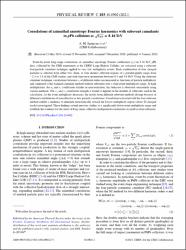| dc.contributor.author | Sirunyan, A. M. | |
| dc.contributor.author | Tumasyan, A. | |
| dc.contributor.author | Adam, W. | |
| dc.contributor.author | Ambrogi, F. | |
| dc.contributor.author | Asilar, E. | |
| dc.contributor.author | Bergauer, T. | |
| dc.contributor.author | Özdemir, Kadri | |
| dc.contributor.author | CMS Collaboration | |
| dc.date.accessioned | 2021-06-05T20:00:03Z | |
| dc.date.available | 2021-06-05T20:00:03Z | |
| dc.date.issued | 2021 | |
| dc.identifier.issn | 2469-9985 | |
| dc.identifier.issn | 2469-9993 | |
| dc.identifier.uri | https://doi.org/10.1103/PhysRevC.103.014902 | |
| dc.identifier.uri | https://hdl.handle.net/20.500.12960/825 | |
| dc.description | WOS:000607510800002 | en_US |
| dc.description.abstract | Event-by-event long-range correlations of azimuthal anisotropy Fourier coefficients (v(n)) in 8.16 TeV pPb data, collected by the CMS experiment at the CERN Large Hadron Collider, are extracted using a subevent four-particle cumulant technique applied to very low multiplicity events. Each combination of four charged particles is selected from either two, three, or four distinct subevent regions of a pseudorapidity range from -2.4 to 2.4 of the CMS tracker, and with transverse momentum between 0.3 and 3.0 GeV. Using the subevent cumulant technique, correlations between v(n) of different orders are measured as functions of particle multiplicity and compared to the standard cumulant method without subevents over a wide event multiplicity range. At high multiplicities, the v(2) and v(3) coefficients exhibit an anticorrelation; this behavior is observed consistently using various methods. The v(2) and v(4) correlation strength is found to depend on the number of subevents used in the calculation. As the event multiplicity decreases, the results from different subevent methods diverge because of different contributions of noncollective or few-particle correlations. Correlations extracted with the four-subevent method exhibit a tendency to diminish monotonically toward the lowest multiplicity region (about 20 charged tracks) investigated. These findings extend previous studies to a significantly lower event multiplicity range and establish the evidence for the onset of long-range collective multiparticle correlations in small system collisions. | en_US |
| dc.language.iso | eng | en_US |
| dc.publisher | Amer Physical Soc | en_US |
| dc.relation.ispartof | Physical Review C | en_US |
| dc.rights | info:eu-repo/semantics/openAccess | en_US |
| dc.subject | Fizik | en_US |
| dc.subject | Physics | en_US |
| dc.title | Correlations of azimuthal anisotropy Fourier harmonics with subevent cumulants in pPb collisions at root s(NN)=8.16 TeV | en_US |
| dc.type | article | en_US |
| dc.authorid | 0000-0002-0103-1488 | |
| dc.department | Mühendislik Fakültesi, Elektrik-Elektronik Mühendisliği Bölümü | en_US |
| dc.contributor.institutionauthor | Özdemir, Kadri | |
| dc.identifier.doi | 10.1103/PhysRevC.103.014902 | |
| dc.identifier.volume | 103 | en_US |
| dc.identifier.issue | 1 | en_US |
| dc.relation.publicationcategory | Makale - Uluslararası Hakemli Dergi - Kurum Öğretim Elemanı | en_US |

















